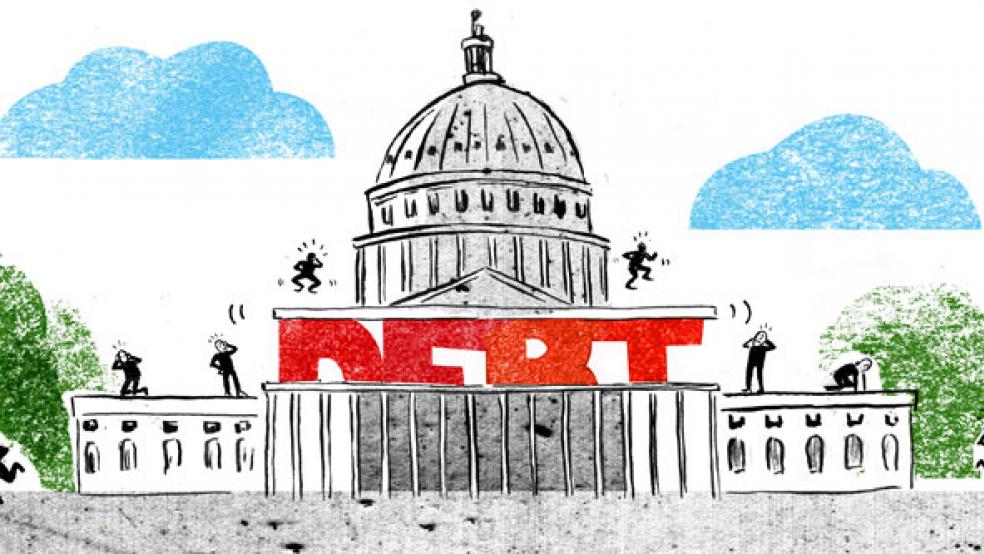The jockeying for position over the coming need to increase the Treasury Department’s borrowing limit, known as the debt ceiling, has begun in Congress. Even though there is little likelihood of real action on the issue until lawmakers return from a month-long August recess, members of the House Freedom Caucus are already preparing a list of recommendations that, as the country drifts closer to a potential federal default, will begin to look and sound more like demands.
The federal government had reached its legal borrowing limit already, and the Treasury has been using a suite of “extraordinary measures” to avoid issuing any securities that would increase outstanding public debt. In reality, though, the process involves delaying certain payments and temporarily shifting federal accounts around, which effectively creates a different kind of debt -- owed internally -- that will eventually come due as well.
Related: A New Republican Agenda Is Taking Shape—and It Means Tax Increases
However, those tactics will no longer work after a certain point, estimated to be in the early fall. Treasury Secretary Steven Mnuchin has called on Congress to pass a debt ceiling increase as soon as possible, hoping to avoid a situation in which the country steps up to the line of default or, in the worst- case scenario, inadvertently crosses over it.
On Sunday, the website Axios reported that the Freedom Caucus was preparing a set of options for Republican House leaders, who will need the group’s support if the GOP wants to pass a debt ceiling increase without making any concessions to the chamber’s Democratic minority.
Rep. Mark Meadows, the group’s chairman, is reportedly backing a plan that would, ostensibly at least, help avoid a crisis both this time and in future debt ceiling battles. The group is backing a proposal that includes legislative language requiring the government to prioritize payments to holders of public debt, even to the point of mandating the sale of GDP-linked bonds to fund the payment of principal and interest.
A bill introduced last week would mandate that “In the event that the Secretary of the Treasury estimates that the debt ceiling will be reached, the Secretary is required to issue GDP-linked bonds to pay the principal and interest on the public debt, and the President is authorized to request the rescission of certain unobligated balances and sell certain mortgage-related assets, and for other purposes.”
The idea assumes -- regarded by many as faulty -- that if the government does not default on its Treasury securities, even if it fails to pay other creditors, it will not be treated by future lenders as though it had failed to meet its obligations.
Related: White House's Debt Ceiling Battle Could Trigger a Shutdown — and Recession
The bill’s requirement that the government sell off federal assets, including land, has been floated many times over the past decade, during which debt ceiling gamesmanship has increased. But experts have warned that selling off non-liquid federal assets is not a viable means of funding the government or of effectively paying down the debt.
The sweetener in the Freedom Caucus proposal is that it would boost the debt ceiling by $1.5 trillion, pushing the next battle over the issue well past the next election cycle.
Should the first option fail, the Freedom Caucus is looking at a pair of backup options that are also political longshots.
The first would be to demand that the debt ceiling increase is tied to a 2018 budget resolution, but that it be accompanied by a $250 billion spending cut. That’s a figure that lawmakers and analysts alike believe would be not just politically, but also practically impossible to achieve.
Related: Mulvaney's Debt Ceiling Ploy Protects Treasurys, Not Social Security
A final option, and probably the farthest-fetched, is attaching a debt ceiling increase to a bill repealing and replacing the Affordable Care Act.
The GOP’s effort to pass a new health care bill is foundering at the moment and the complications of passing it through the Senate’s budget reconciliation process, severely limit the Senate’s options when it comes to adding other measures to it. It would also add a new layer of political complexity to an effort already mired in Capitol Hill gridlock.
The Freedom Caucus’ proposal is almost certainly just the first volley in a battle that -- calls for haste notwithstanding -- will likely rage well into September.





